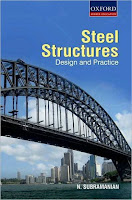Steel Structures: Design and Practice
 N. Subramanian ... 864 pages - Publisher: Oxford Univ. Press; (March, 2011) ... Language: English - ISBN-10: 0198068816 - ISBN-13: 978-0198068815
N. Subramanian ... 864 pages - Publisher: Oxford Univ. Press; (March, 2011) ... Language: English - ISBN-10: 0198068816 - ISBN-13: 978-0198068815Design of Steel Structures is designed to meet the requirements of undergraduate students of civil and structural engineering. This book will also prove useful for postgraduate students and serve as an invaluable reference for practicing engineers unfamiliar with the limit state design of steel structures. The book provides an extensive coverage of the design of steel structures in accordance with the latest code of practice for general construction in steel (IS 800 : 2007). The book is based on the modern limit state approach to design and covers topics such as properties of steel, types of steel structures, important areas of structural steel technology, bolted connections, welded connections, design of trusses, design of plate girders, and design of beam columns. Each chapter features solved examples, review questions, and practice problems as well as ample illustrations to supplement the text.


















